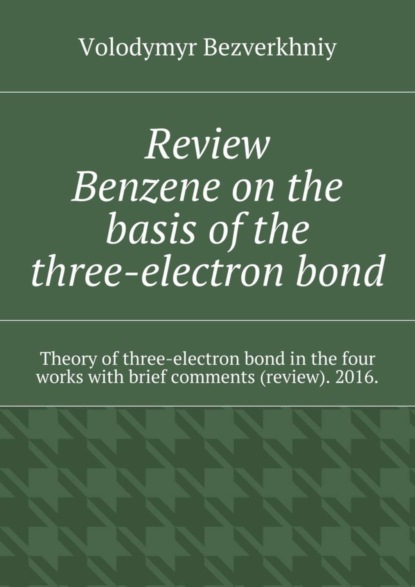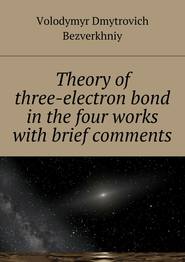По всем вопросам обращайтесь на: info@litportal.ru
(©) 2003-2024.
✖
Review. Benzene on the basis of the three-electron bond. Theory of three-electron bond in the four works with brief comments (review). 2016.
Настройки чтения
Размер шрифта
Высота строк
Поля
Lets show it on figure.
benzene on the basis of the three-electron bond, distance between electrons (benzene, cyclooctatetraene, cyclodecapentaene)
As we can see distance between neighboring central electrons 1 and 2 in benzene makes up 1.210 ?, in regular octagon 1.303 ?, and in regular decagon 1.331 ? (almost as distance between carbon atoms in ethene molecule). That is by going from benzene to regular octagon and decagon not only angular pressure (0°, 15°, 24°) and distance between central electrons increase, which are situated on the opposite sides (2.420 ?; 3.404 ?; 4.309 ?), as well as distance between neighboring central electrons 1 and 2 (1.210 ?; 1.303 ?; 1.331 ?), that causes considerable weakening of interaction through the cycle in regular decagon. That’s why regular hexagon (benzene) is ideal aromatic system. As angular pressure is equal to zero, distances between central electrons both neighboring and situated on the opposite sides are minimal (accordingly 1.210 ? and 2.420 ?). I.e. interaction through the cycle will be maximal. By going to regular decagon these advantages will be lost. That’s why cyclodecapentaene is olefin.
Let us note for comparison that if we take Lc-c = 1.400 ? for the planar cyclooctatetraen, we will have L (1—5) = 3.380 ?, L (1—2) = L (8—1) = 1.293 ? which vary just slightly from the above mentioned distances between the central electrons at Lс-с = 1.410 ?.
By means of the interaction through the cycle together with the three-electron bond, aromaticity of coronen, [18] -annulene, naphthalene and other organics substances can be explained (see conclusion).
Now let’s pass to the definition of delocalization energy of benzene. It is easy to show, that relation multiplicity = f (L) and Е = f (L), where multiplicity is multiplicity of bond, L – length of bond in ?, Е – energy of bond in kj/mole will be described by function y = a + b/x + c/x? for any types of bond (C-C, C-N, C-O, C-S, N-N, N-O, O-O, C-P).
We shall consider ethane, ethylene and acetylene to be initial points for the c-c bond.
For lengths of bonds let us take the date [7]:
bond lengths in ethane, ethylene and acetylene
As usual, the С-С bond multiplicity in ethane, ethylene and acetylene is taken for 1, 2, 3.
For energies of bonds let us take the date [7, p. 116]:
energies of bonds in ethane, ethylene and acetylene
The given bond energies (according to L. Pauling) are bond energy constants expressing the energy that would be spent for an ideal rupture of these bonds without any further rebuilding of the resulting fragments. That is, the above mentioned energies are not bond dissociation energies.
Having performed all necessary calculations we obtain the equation:
(1)
(2)
From these equations we find:
c—c benzene multiplicity (L = 1.397 ?) = 1.658
c—c graphite multiplicity (L = 1.42 ?) = 1.538 ? 1.54
Ec—c benzene (L = 1.397 ?) = 534.0723 kj/mole
Ec—c graphite (L = 1.42 ?) = 503.3161 kj/mole
Being aware that the benzene has the three-electron bonds and also the interaction through the cycle, we can calculate the interaction through the cycle energy.
benzene on the basis of the three-electron bond, interaction through the cycle
(3)
from the equation we find L = 1.42757236 ?.
So, if the benzene molecule had a «clean» three-electron bond with a 1.5 multiplicity the c-c bond length would be L = 1.42757236 ?.
Now let us determine the energy of the «clean» three-electron bond with a 1.5 multiplicity knowing its length L = 1.42757236 ?:
Ec – c (L =1.42757236 ?) = 493.3097 kj/mole
Taking into account that the benzene c-c bond energy with a 1.658 multiplicity is equal to Ec-c benzene = 534.0723 kj/mole, the difference will make:
?E = 534.0723 kj/mole – 493.3097 kj/mole = 40.7626 kj/mole.
40.7626 kj/mole is the energy of interaction through the cycle per one c-c bond. Therefore, the energy of interaction through the cycle will be two times higher:
E
= 40.7626 kj/mole ? 2 = 81.5252 kj/mole (19.472 kcal/mole)
It is clear that the three interactions through the cycle present precisely the working benzene delocalization energy which is:
E = 3E
= 3 ? 81.5252 kj/mole = 244.5756 kj/mole (58.416 kcal/mole)
benzene on the basis of the three-electron bond, delocalization energy
It is also possible to calculate the benzene molecule energy gain in comparison with the curved cyclohexatriene (let us assume that energy of C-H bonds in these molecules is similar). For this we calculate the sum of energies of single and double c-c bonds in cyclohexatriene:
E
= 3Ec—c +3Ec?c = 2890.286 kj/mole
The energy of six benzene c-c bonds with a 1.658 multiplicity is equal to:
E
= 6 · 534.0723 kj/mole = 3204.434 kj/mole
Therefore, the gain energy of benzene compared to cyclohexatriene will amount to:
E = E
– E
= 3204.434 kj/mole – 2890.286 kj/mole = 314.148 kj/mole (75.033 kcal/mole).
2.2. Experimental
Let’s show more detailed calculation of ratios for our mathematical relations. Let’s consider relation Multiplicity = f (L) and E = f (L) for С-С bonds, where multiplicity is multiplicity of bond, L – length of bond in ?, Е – energy of bond in kj/mole.
As initial points for the given bonds we will use ethane, ethene and acetylene. For the length of bonds let us take the findings [7]:






